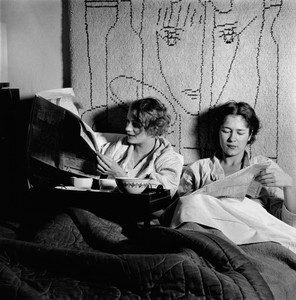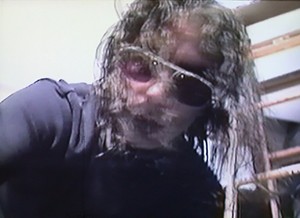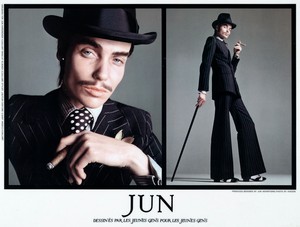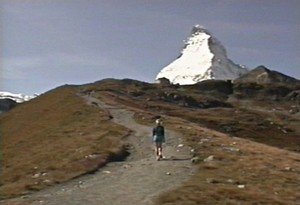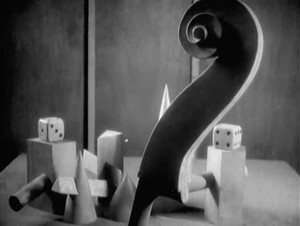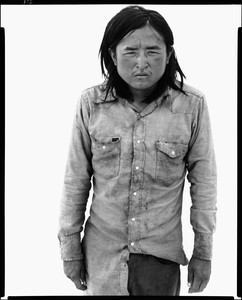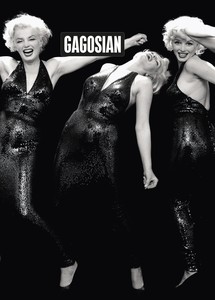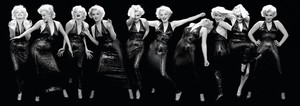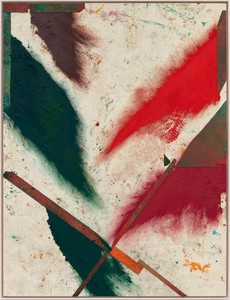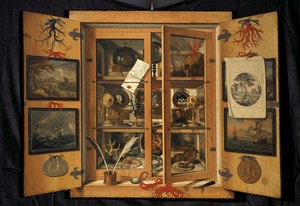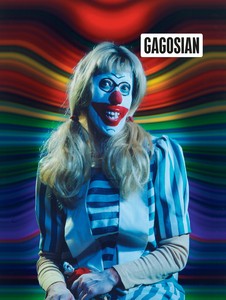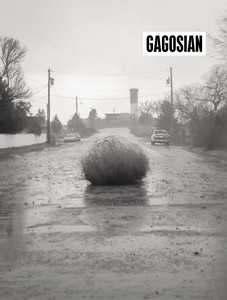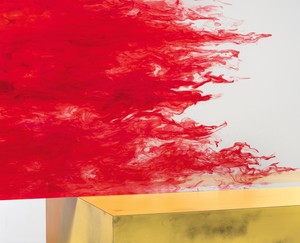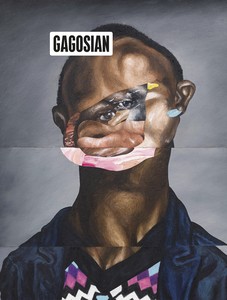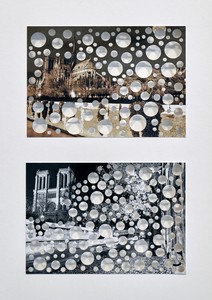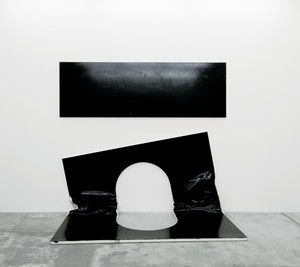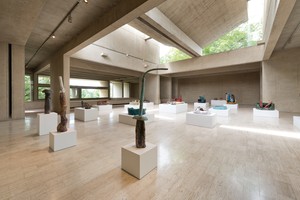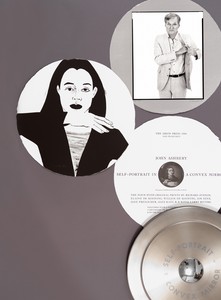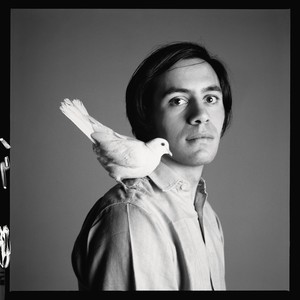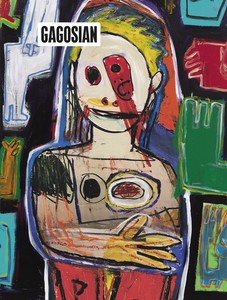You’re only as young as the last time you changed your mind.
—Timothy Leary
Broadcast: Alternate Meanings in Film and Video employs the innate immediacy of time-based art to spark reflection on the here and now. Looking to the late 1960s—a historical moment marked by deep uncertainty, social unrest, and radical transformation—this online exhibition loosely adopts famed psychologist and countercultural icon Timothy Leary’s mantra “turn on, tune in, drop out” as a guide for negotiating our present moment.
The third chapter presents five films and videos by artists who adopt experimental approaches to explore the unique potential of their respective mediums.
In “Turn On,” William Forsythe and Steven Parrino use unconventional means to generate awareness of their immediate environments. In Alignigung II (2017), Forsythe treats the intertwined bodies of his two performers as tools for exploring the limits of the self and other. In Guitar Grind (1995), Parrino “turns on” to the possibility of using the bass guitar and amplifier atypically, whether as a “bow” for a guitar or an apparatus to generate feedback noise, respectively.
The two works included in the “Tune In” section represent divergent approaches to complicating mass-media conventions. In his commercial for fashion brand Jun Ropé in 1973, Richard Avedon presents an exploration of the social performance of gender identity that deviates from the typical content found in the television advertisement genre at the time. In Hiker (2003), Sterling Ruby deploys various horror film techniques—such as a lurking camera perspective and evocative sound design—in a short video of a female trekker ascending a mountain, casting a sinister pall over the otherwise innocuous visual content.
Representing the curatorial category of “Drop Out,” Man Ray’s film Emak Bakia (1926) exemplifies the visionary techniques and oneiric imagery that characterize the early twentieth-century avant-garde movements of Dada and Surrealism, which sought to awaken contemporary society to alternative possible realities no longer beholden to rational thought.
Each chapter of Broadcast will introduce a new set of films and videos on Tuesdays. The next chapter will debut on July 21.
“Turn On”
William Forsythe
Alignigung II, 2017
In a video installation distilled from a live performance that Forsythe choreographed and directed in 2016, dancers Rauf “Rubberlegz” Yasit and Riley Watts clasp and unclasp each other in complex configurations that make it difficult for the viewer to determine where one body ends and the other begins. This slow-motion physical and optical puzzle, which Forsythe calls an “entanglement,” is a choreographic event from which the common elements typically associated with choreography—the structural development of time and space and the visual isolation of parts—have been subtracted. The complex “threading” of the dancers’ bodies into their own negative spaces creates visual conundrums that defy the apparent logic of the situation. The title is a play on words that, like the human situation it describes, threads two languages together: the English word align, which sounds like the German word allein (alone), is fused with the German word Einigung (agreement). The result is both a pun and a paradox—to align with oneself and another at the same time.
Steven Parrino
Guitar Grind, 1995
Guitar Grind opens abruptly with an overhead shot of Parrino, clad in sunglasses and a T-shirt, as he begins sliding his bass guitar—positioned facedown like a violin bow—against a guitar resting atop its case, causing a somewhat unholy racket. Occasionally reaching up to tweak the amplifier or manipulate the guitar pedal to produce screeching and howling feedback, Parrino uses the instruments unconventionally so that together they project a discordant noise. The artist masterfully draws the listener in to hear repetitions, subtle variations, and musical gestures in the unusual sonic palette. Shot by a lone cameraperson, the visuals of Parrino’s performance become increasingly abstract as the music develops into a more familiar and alluring language.
“Tune In”
Richard Avedon
Veruschka for Jun Ropé, hair by Ara Gallant, makeup by Way Bandy, styling by J. Butler, wardrobe by Giorgio di Sant’ Angelo and Ara Gallant, December 1973
Avedon’s commercial advertisement for the Japanese womenswear brand Jun Ropé features an innovative and unexpected approach to the genre that reflects the famed photographer’s exceptional signature style. Opening onto a behind-the-scenes look at a photo shoot, the camera follows the supermodel Veruschka as she transforms from a suit-clad, mustached character in drag to an unabashedly glamorous fashion icon dressed in a designer gown and posing for Avedon himself. While initially produced for a commercial client with the leading industry talents of the day, the video underscores the artist’s savvy understanding of the performative—and ultimately flexible—nature of social constructions of gender, femininity, and the self.
Sterling Ruby
Hiker, 2003
A handheld camera trails a woman as she hikes up the Matterhorn. Suspense rises as she ascends, accompanied by a horror movie soundtrack. The shaky camera offers no reverse shots, implying the presence of an imminent threat. Drawing on the trope of the first-person “killer POV” as identified by film theory, the lack of camera attribution implicates the viewer as the potential stalker. Additionally inspired by Edmund Burke’s writing on the terror-provoking quality of the sublime, the soundtrack intensifies in volume each time the camera pans out across the majestic, nearly unfathomable landscape. Though alpine climaxes come into view, the unrelenting sound never allows tension to be released.
“Drop Out”
Man Ray
Emak Bakia, 1926
Emak Bakia was financed by the retired American stockbroker Arthur Wheeler; the title, which is French Basque for “leave me alone,” is taken from the name of Wheeler’s villa near Biarritz where Man Ray stayed while he produced the film. Subtitled a “cinépoème,” Emak Bakia melds Dadaist and Surrealist imagery in a succession of seemingly unrelated scenes: a woman dancing the Charleston; fish swimming idly about; Man Ray’s own rotating sculptures; and his muse, Kiki de Montparnasse, opening and closing her eyes, with a second pair of eyes painted on her lids. Featuring concepts from his still photography, such as rayographs and double exposures, in addition to new cinematographic techniques such as stop-motion, Emak Bakia encapsulates many of Man Ray’s interests as an artist, filmmaker, and poet.
